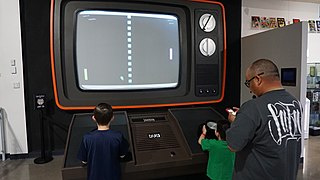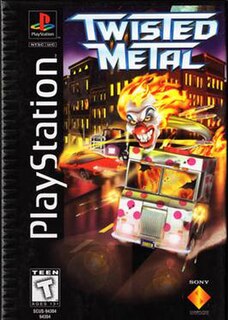
A video game or computer game is an electronic game that involves interaction with a user interface or input device – such as a joystick, controller, keyboard, or motion sensing device – to generate visual feedback. This feedback is shown on a video display device, such as a TV set, monitor, touchscreen, or virtual reality headset. Video games are often augmented with audio feedback delivered through speakers or headphones, and sometimes with other types of feedback, including haptic technology.

The Intellivision is a home video game console released by Mattel Electronics in 1979. The name Intellivision is a portmanteau of "intelligent television". Development of the console began in 1977, the same year as the introduction of its main competitor, the Atari 2600. In 1984, Mattel sold their video game assets to a former Mattel Electronics executive and investors who formed an entity that became INTV Corporation. Games development started in 1978 and continued until 1990 when the Intellivision was discontinued. From 1980 to 1983 over 3 million Intellivision units were sold.

The PlayStation is a home video game console developed and marketed by Sony Computer Entertainment. It was first released on 3 December 1994 in Japan, 9 September 1995 in North America, 29 September 1995 in Europe, and 15 November 1995 in Australia, and was the first of the PlayStation line of video game consoles. As a fifth generation console, the PlayStation primarily competed with the Nintendo 64 and the Sega Saturn.

Pong is a table tennis–themed arcade sports video game, featuring simple two-dimensional graphics, manufactured by Atari and originally released in 1972. It was one of the earliest arcade video games; it was created by Allan Alcorn as a training exercise assigned to him by Atari co-founder Nolan Bushnell, but Bushnell and Atari co-founder Ted Dabney were surprised by the quality of Alcorn's work and decided to manufacture the game. Bushnell based the game's concept on an electronic ping-pong game included in the Magnavox Odyssey, the first home video game console. In response, Magnavox later sued Atari for patent infringement.

The history of video games began in the 1950s and 1960s as computer scientists began designing simple games and simulations on mainframe computers, with MIT's Spacewar! in 1962 as one of the first such games to be played with a video display. The early 1970s brought the first consumer-ready video game hardware: the first home video game console, the Magnavox Odyssey, and the first arcade video games from Atari, Computer Space and Pong, the latter which was later made into a home console version. Numerous companies sprang up to capture Pong's success in both the arcade and the home by creating clones of the game, causing a market contraction in 1978 due to oversaturation and lack of innovation.

A light gun is a pointing device for computers and a control device for arcade and video games, typically shaped to resemble a pistol. In aviation and shipping, it can also be a directional signal lamp.
A game controller, gaming controller, or simply controller, is an input device used with video games or entertainment systems to provide input to a video game, typically to control an object or character in the game. Before the seventh generation of video game consoles, plugging in a controller into one of a console's controller ports were the primary means of using a game controller, although since then they have been replaced by wireless controllers, which do not require controller ports on the console but are battery-powered. USB game controllers could also be connected to a computer with a USB port. Input devices that have been classified as game controllers include keyboards, mouses, gamepads, joysticks, etc. Special purpose devices, such as steering wheels for driving games and light guns for shooting games, are also game controllers.

Industrial Light & Magic (ILM) is an American motion picture visual effects company that was founded in May 1975 by George Lucas. It is a division of the film production company Lucasfilm, which Lucas founded, and was created when Lucas began production of the film Star Wars.

Racing games are a video game genre in which the player participates in a racing competition. They may be based on anything from real-world racing leagues to fantastical settings. They are distributed along a spectrum between simulations and simplified arcade-style racing games. Go-kart racing games emerged in the 1990s as a popular sub-genre of the latter. Racing games may also fall under the category of sports games.
A multiplayer video game is a video game in which more than one person can play in the same game environment at the same time, either locally or online over the internet. Multiplayer games usually require players to share a single game system or use networking technology to play together over a greater distance; players may compete against one or more human contestants, work cooperatively with a human partner to achieve a common goal, or supervise other players' activity. Due to multiplayer games allowing players to interact with other individuals, they provide an element of social communication absent from single-player games.
In the history of computer and video games, the third generation began on July 15, 1983, with the Japanese release of two systems: the Nintendo Family Computer and the Sega SG-1000. When the Famicom was released outside of Japan it was remodelled and marketed as the Nintendo Entertainment System (NES). This generation marked the end of the video game crash of 1983, and a shift in the dominance of home video game manufacturers from the United States to Japan. Handheld consoles were not a major part of this generation, although the Game & Watch line from Nintendo and the Milton Bradley Microvision were sold at the time. However, both are considered second generation hardware.
The history of video game consoles, both home and handheld, had their origins in the 1970s. The concept of home consoles used to play games on a television set was founded by the 1972 Magnavox Odyssey, first conceived by Ralph H. Baer in 1966. Handheld consoles bore out from electro-mechanical games that had used mechanical controls and light-emitting diodes (LED) as visual indicators. Handheld electronic games had replaced the mechanical controls with electronic and digital components, and with the introduction of Liquid-crystal display (LCD) to create video-like screens with programmable pixels, systems like the Microvision and the Game & Watch became the first handheld video game consoles, and fully realized by the Game Boy system.

Jumping Flash! is a first-person platform video game co-developed by Exact and Ultra and published by Sony Computer Entertainment. The first installment in the Jumping Flash! series, it was first released for the PlayStation on 28 April 1995 in Japan, 29 September in Europe and 1 November in North America. It was re-released through the PlayStation Network store on PlayStation 3 and PlayStation Portable in 2007.
A PC game, also known as a computer game, is a type of video game played on a personal computer (PC) rather than a video game console or arcade machine. Its defining characteristics include: more diverse and user-determined gaming hardware and software; and generally greater capacity in input, processing, video and audio output. The uncoordinated nature of the PC game market, and now its lack of physical media, make precisely assessing its size difficult. In 2018, the global PC games market was valued at about $27.7 billion.
An interactive film is a video game or other interactive media that has characteristics of a cinematic film. In the video game industry, the term refers to a movie game, a video game that presents its gameplay in a cinematic, scripted manner, often through the use of full-motion video of either animated or live-action footage. In the film industry, the term refers to interactive cinema, a film where one or more viewers can interact with the film and influence the events that unfold in the film.
An electronic game is any game that employs electronics to create an interactive system with which a player can play. Video games are the most common form today, and for this reason the two terms are often used interchangeably. There are other common forms of electronic game including handheld electronic games, standalone systems, and exclusively non-visual products.
The Family Entertainment and Copyright Act, Pub. L. 109-9, 119 Stat. 218, is a federal legislative act regarding copyright that became law in the United States in 2005. The Act consists of two subparts: the Artist's Rights and Theft Prevention Act of 2005, which increases penalties for copyright infringement, and the Family Home Movie Act of 2005, which permits the development of technology to "sanitize" potentially offensive DVD and VOD content.
In the history of video games, the second-generation era refers to computer and video games, video game consoles, and handheld video game consoles available from 1976 to 1992. Notable platforms of the second generation include the Fairchild Channel F, Atari 2600, Intellivision, Odyssey 2, and ColecoVision. The generation began in November 1976 with the release of the Fairchild Channel F. This was followed by the Atari 2600 in 1977, Magnavox Odyssey² in 1978, Intellivision in 1980 and then the Emerson Arcadia 2001, ColecoVision, Atari 5200, and Vectrex, all in 1982. By the end of the era, there were over 15 different consoles. It coincided with, and was partly fuelled by, the golden age of arcade video games. This peak era of popularity and innovation for the medium resulted in many games for second generation home consoles being ports of arcade games. Space Invaders, the first "killer app" arcade game to be ported, was released in 1980 for the Atari 2600, though earlier Atari-published arcade games were ported to the 2600 previously. Coleco packaged Nintendo's Donkey Kong with the ColecoVision when it was released in August 1982.

Twisted Metal is a vehicular combat video game developed by SingleTrac, produced by Sony Interactive Studios America, and published by Sony Computer Entertainment for the PlayStation. The game was released in North America on November 5, 1995, in Europe on January 13, 1996 and in Japan on November 15, 1996. The North American version was re-released for the Sony Greatest Hits line-up on March 3, 1997. It is the first installment in the Twisted Metal series. The game's plot is centered on the titular competition in which various drivers in modified vehicles must destroy the other vehicles in an attempt to be the last one alive. The winner meets the organizer of the competition, a mysterious man named Calypso, who will grant the winner a single wish, regardless of price, size or even reality.
PlayStation is a video game brand that consists of five home video game consoles, as well as a media center, an online service, a line of controllers, two handhelds and a phone, as well as multiple magazines. The brand is produced by Sony Interactive Entertainment, a division of Sony; the first PlayStation console was released in Japan in December 1994, and worldwide the following year.










